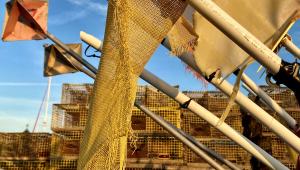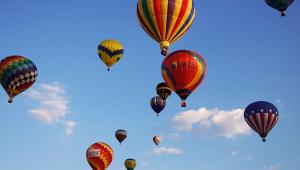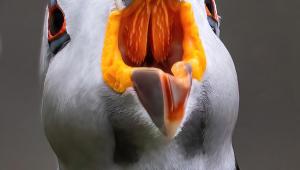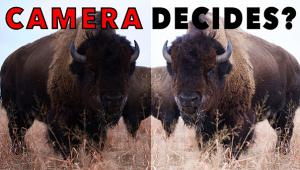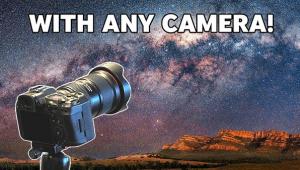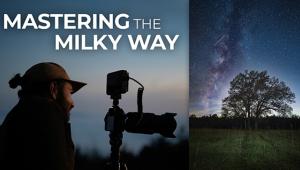The Canon F-1 35mm SLR; A Real Pro Of Its Time Page 2
At the time there were 40 different Canon FD breech-lock mount interchangeable
lenses, most of which were prime (single) focal length ranging from a fisheye
7.5mm up to a 1200mm long telephoto. A couple of zoom lenses were initially
available, and many more came along later. Among the first system zoom lenses
offered were a 55-135mm f/3.5, 100-200mm f/5.6, and 85-300mm f/5.
Motorized Advance
Two motor drives were offered. Both were easily attached by simply removing the bottom cover plate on the camera and attaching the motor drive housing, which coupled with camera drive mechanisms located inside the F-1 body. Other system cameras back then required factory modification before a motor drive could be attached. One model had a handle protruding from the bottom for easier gripping and an external battery pack for AA-size batteries. The later Motor Drive MF had a thicker base plate and a side grip that housed the batteries. The side grip had a convenient shutter release button on the top and could drive the film for 3.5 fps continuous shooting.
The F-1 was truly modular since the viewfinder could be removed and changed. The base plate came off for attaching a motor drive, and the entire camera back could be removed when the long roll, 250 exposure, film magazine was attached. Among the numerous optional accessories were two different bellows, various extension tubes, close-up lenses, a copying stand, slide duplicating bellows, and microscope tube attachments.
When introduced, the suggested list price of the Canon F-1 with the FD 50mm f/1.4 lens was $500. The Motor Drive was $345; the Servo EE Finder $280; the Booster T Finder $225; and the Speed Finder $150.
Lens Mounts
The new Canon FD bayonet mount lenses featured an improved mounting system from the earlier Canon FL lenses. There is no unlocking button or lever. You simply turned the large knurled ring closest to the camera body about 75Þ counterclockwise to unlock the lens, then pulled straight out to remove it. The spring-loaded locking mechanism automatically locked in the open position. To reattach a lens, you aligned the red dot on the lens with a red dot on the top center of the body and gently pressed the lens in toward the body. The locking ring then partially revolved clockwise toward the locking position. You then continued turning the locking ring slightly until it stopped to properly seat and lock the lens in place. The spring mechanism made it much quicker to remove and lock the lenses onto the body. Each lens had a click-stop for both full and half stop aperture settings. It takes about a 180Þ turn of the rubberized knurled ring at the front of the lens to focus from infinity to 2 ft (on the 50mm f/1.4
normal lens that is).
Through the decades since this camera was introduced I have exposed many hundreds of rolls of all types of film in the two F-1 bodies and dozens of FD mount lenses I still own. It has proven to be both rugged and reliable under a wide variety of weather and use situations both in studios and on location. The sharp detail and excellent quality of these images was always consistently superior to those made with the many other makes of 35mm SLR cameras I have used or owned.
Later upgraded models included the F-1n in '76 and the new F-1 in '81, each with more internal electronics and more sophisticated metering. To keep the system concept intact, they accepted all Canon FD mount lenses and most of the numerous accessories designed for the original Canon F-1.
The Canon F-1 was a leading professional SLR camera that was competitive in all aspects with the other SLR models available in the early '70s. It had an extensive following with photojournalists and active pro photographers of all types in its heyday. It is still a very competent camera today if you like a manually operated camera.
Motorized Advance
Two motor drives were offered. Both were easily attached by simply removing the bottom cover plate on the camera and attaching the motor drive housing, which coupled with camera drive mechanisms located inside the F-1 body. Other system cameras back then required factory modification before a motor drive could be attached. One model had a handle protruding from the bottom for easier gripping and an external battery pack for AA-size batteries. The later Motor Drive MF had a thicker base plate and a side grip that housed the batteries. The side grip had a convenient shutter release button on the top and could drive the film for 3.5 fps continuous shooting.
The F-1 was truly modular since the viewfinder could be removed and changed. The base plate came off for attaching a motor drive, and the entire camera back could be removed when the long roll, 250 exposure, film magazine was attached. Among the numerous optional accessories were two different bellows, various extension tubes, close-up lenses, a copying stand, slide duplicating bellows, and microscope tube attachments.
When introduced, the suggested list price of the Canon F-1 with the FD 50mm f/1.4 lens was $500. The Motor Drive was $345; the Servo EE Finder $280; the Booster T Finder $225; and the Speed Finder $150.
Lens Mounts
The new Canon FD bayonet mount lenses featured an improved mounting system from the earlier Canon FL lenses. There is no unlocking button or lever. You simply turned the large knurled ring closest to the camera body about 75Þ counterclockwise to unlock the lens, then pulled straight out to remove it. The spring-loaded locking mechanism automatically locked in the open position. To reattach a lens, you aligned the red dot on the lens with a red dot on the top center of the body and gently pressed the lens in toward the body. The locking ring then partially revolved clockwise toward the locking position. You then continued turning the locking ring slightly until it stopped to properly seat and lock the lens in place. The spring mechanism made it much quicker to remove and lock the lenses onto the body. Each lens had a click-stop for both full and half stop aperture settings. It takes about a 180Þ turn of the rubberized knurled ring at the front of the lens to focus from infinity to 2 ft (on the 50mm f/1.4
normal lens that is).
Through the decades since this camera was introduced I have exposed many hundreds of rolls of all types of film in the two F-1 bodies and dozens of FD mount lenses I still own. It has proven to be both rugged and reliable under a wide variety of weather and use situations both in studios and on location. The sharp detail and excellent quality of these images was always consistently superior to those made with the many other makes of 35mm SLR cameras I have used or owned.
Later upgraded models included the F-1n in '76 and the new F-1 in '81, each with more internal electronics and more sophisticated metering. To keep the system concept intact, they accepted all Canon FD mount lenses and most of the numerous accessories designed for the original Canon F-1.
The Canon F-1 was a leading professional SLR camera that was competitive in all aspects with the other SLR models available in the early '70s. It had an extensive following with photojournalists and active pro photographers of all types in its heyday. It is still a very competent camera today if you like a manually operated camera.
- Log in or register to post comments
